
 |
|
They say that the tea master Rikyu became enamored with the man who delivered fish to his home. In those days, the upper class like Rikyu rarely mingled with the peasantry. But Rikyu was a Chajin. He made it clear to the household that any time the fisherman came, he wanted to be there to receive the fish personally. After some years, the two became close. Then, one day, Rikyu noticed that the fisherman had something on his mind. He thought that he needed help, so he asked him what the matter was. The poor fisherman looked at his feet, nervous: "It's just that...well... I know you cannot, and would not... but my wife and I, well...we want to invite you to our home for tea." Rikyu smiled. Of course he would go. On the appointed day, Rikyu took his highest student - to honor the fisherman, letting him know he was in no way embarrassed by their relationship. They drank some tea and had a small meal. After they left, and the gate swung shut, Rikyu stopped, sighed and exclaimed: "That was one of the most transcendent tea sessions of my entire life!" They walked on silently, until the student couldn't take it anymore. His confusion complete, he stopped his teacher in askance: "Master, I do not understand. That man did everything wrong! He nearly dropped the tea bowl twice, spilled the tea powder and did not whisk it properly, either. And those are just a few of his mistakes. How could that have been one of the most transcendent tea sessions of your life?" Rikyu's brow furrowed and he looked his student deeply in the eyes: "That man did not invite us to his home to demonstrate his tea brewing skills!"
The story ends there, but if we sketch it forward on our own, we can find a deep and lasting parallel for Zen, as well as the relationship between bowl tea and gongfu tea. For, you see, the very next day we can be sure that Rikyu would be found scolding his students for their mistakes. Imagine his stern face, rebuking that same student for holding the whisk improperly. And yet, even with a mastery founded on decades of practice and insight, Rikyu still found the radiance in the fisherman's simple tea. That is the spirit of tea, and the way that bowl tea and gongfu tea work together: refining our skills and keeping us grounded in what tea is really about.
If you can, like Rikyu, master tea without losing the spirit of simplicity and the beginner's mind, you will indeed have found the Dao of Cha. There is more tea information to study than a lifetime permits. And even near the end of my life, I hope to be improving and growing my brewing skills. Master Lin often says that the highest gongfu is when we can differentiate every single leaf, "for Heaven makes no two leaves alike!" I believe that part of his message in that teaching is that the "highest" gongfu is unachievable, and we must therefore practice humility, on the one hand, and strive to continue learning throughout our lives on the other. That there is always more to learn keeps us open, receptive and unpretentious in our practice. It also keeps things interesting and inspiring, so that we can continue to approach our tea practice with enthusiasm, even after much effort and growth. "Still in love after all these years!" is another of my favorite sayings Master Lin is fond of. I, too, fall more and more in love with the Leaf each year. This powerful relationship between a growing mastery and a connection to the spirit, simplicity and love with which one began is facilitated in our Center by the relationship between bowl tea and gongfu tea. Let us, therefore, discuss each one individually and then turn to how they work together in conjunction.
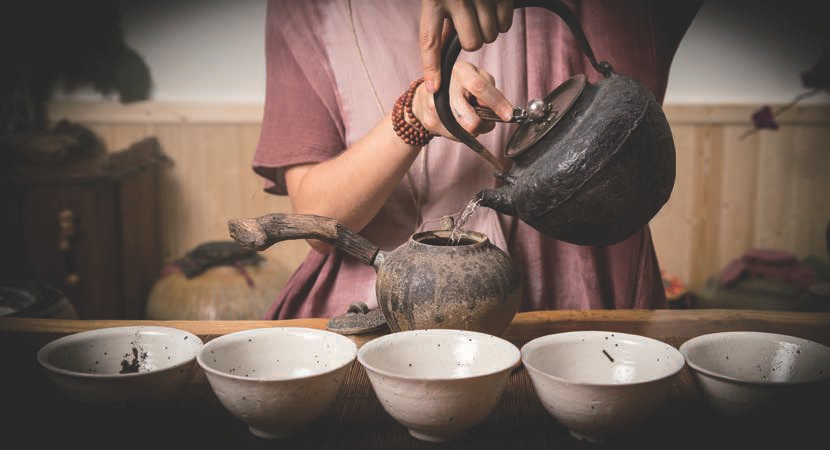
Bowl tea is about simplicity, meditation and sacred space. Bowl tea is for equanimity, so that we learn to turn off the qualitative mind and rest in a higher state of meditation with our tea. On the absolute level, quality is not real. If you take ten grams of the most expensive thousand-dollar tea and ten grams of simple two-dollar tea and put them next to one another in the forest, they turn into twenty grams of dirt. And the frogs don't care which was which. Neither does the sun. Quality is mind-made; it's subjective. In its essence, tea is leaves, heat and water. There is a great power in being able to rest in a sacred space with a bowl of tea, sharing ceremony with others.
As ceremony, bowl tea connects us to Nature, ourselves and others. When we drink tea in a sacred, ceremonial space we feel a part of the Nature that gave us the tea - as it streams into us and becomes our body, mind and soul. The water in a bowl of tea was literally in the clouds just weeks ago. And the tea is different every season, so we are drinking the weather. The trees connect us to the minerals of the Earth and the light of Heaven, through the sun, moon and starshine they photosynthesize. This is tea as medicine, as it was drunk for thousands of years by aboriginal shamans - long before anyone began refining its processing or preparation. In such a tea space, we also find the opportunity to rest in Stillness, to be meditative and withdraw from the world to an inward state.
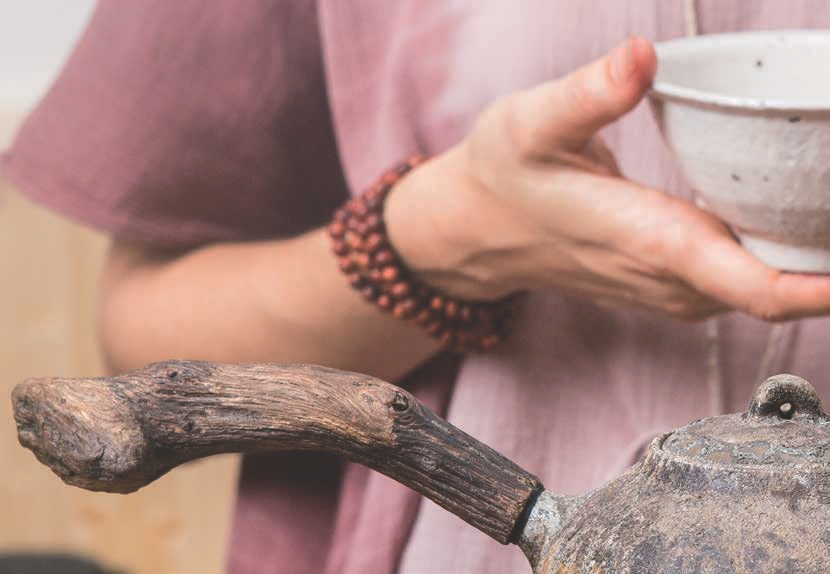
Without a viable connection to one's own intuitive wisdom, there is little chance at living skillfully, or mastering any art. We need meditation like we need air. And peace is really as simple as a bowl of tea. It is a natural happening. You can't struggle for peace - that would be like trying to calm water by slapping the ripples away. It is in the water's nature to purify. Even the most turbid water will clarify if you but leave it at rest, in stillness. As soon as the water stops moving, it naturally starts to separate from that which it is not - the mud sinks to the bottom and the water becomes clear. When we sit still, our hearts similarly separate from all that is not real. All our dramas, fears and egoic dilemmas sink down, as the present moment rises up pure and clear. Such clarity affords us the opportunity to acknowledge what is truly important in our lives, to have the perspective to map our journey, make righteous decisions and be more celebratory of our one and only life on this Earth! A bowl of tea can be a catalyst to such meditative, clear, present and pure space.
The ceremony of sharing tea freely, as an act of kindness - pure hospitality - also facilitates connection with our loved ones. It allows us to make new friends and celebrate the old. In a calm heart space, we can really see the other. We can look into each other's eyes without all the distractions of technology or life. Whether we converse or simply sit together in silence, such a space allows us to really see the other. Such empathy brings harmony between people.
When I first started traveling and teaching tea in the early 2000s, I would prepare gongfu tea for people. If I returned a year later and asked people about their tea practice, many would exclaim, "What tea practice?!" I realized that gongfu tea was inaccessible to many of them. There are too many implements, too much complication. Bowl tea is accessible. In its simplest form, you only need a bowl of any kind and some hot water. Simply put the leaves in the bowl and add water. The ceremonial simplicity of bowl tea makes it the perfect place to enter the tea journey. And the soul of one's practice is much more important than the skills, anyway. Learning about tea is easier these days, with magazines like this one. Even the skills needed to prepare fine tea are there, if we practice them. But all art must start with the soul.
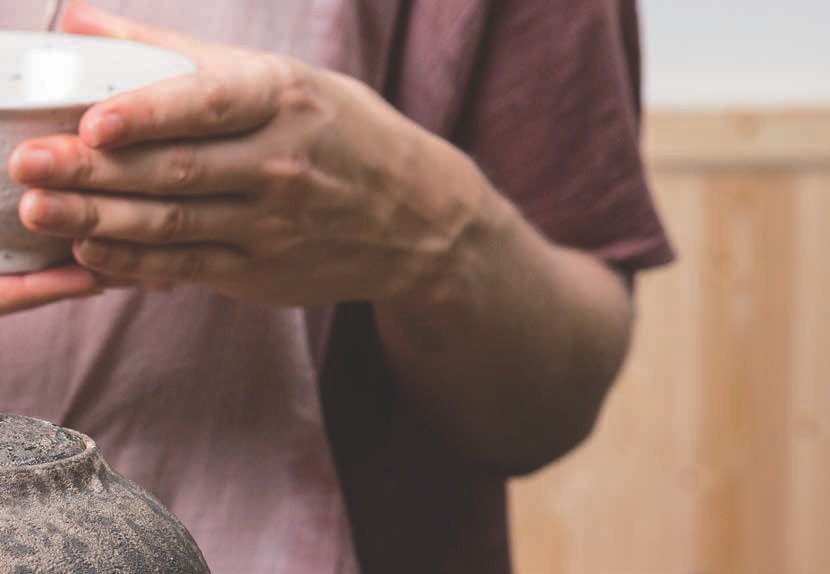
All the skill in the world is vacuous if it is in service of ego. Would you rather see Anthony Hopkins alone on a stage performing his favorite scenes or Transformers Seven? Hopefully you answered the former. But Transformers Seven required much more skill to produce. The credits literally take ten minutes to pass by, because hundreds, if not thousands, of highly-skilled masters were involved in its creation. There were master lighting technicians, cameramen, CGI masters, and so on. And that doesn't include the second tier of experts, who engineered the cameras, computers or software, for example. And yet, it all lacks the soul of Anthony Hopkins' performance. This is true of any art. A similar analogy might be found in comparing Bob Dylan alone on a stage with an acoustic guitar and a harmonica, brimming with soul, to a pop diva surrounded by fireworks, lasers, highly choreographed dances, elaborate costumes, etc. The soul separates art from entertainment.
There is an old Daoist story in which a master archer was in the town square slapping arrow after arrow into the bullseye. A crowd gathered, cheering him on. But the proud archer noticed that the local oil vendor, whose cart was nearby, was ignoring him. He resented this, stomping over to the cart to scold the poor oil vendor. "Hey! Can't you see my skills? Haven't you noticed how many bullseye shots I just made in a row? You didn't even applaud me!" The oil vendor calmly replied, "I'm not impressed." The archer was offended and demanded an explanation. "You are skilled, indeed, but I am not impressed. You achieved that through years of practice. If others practiced archery as often as you, they would also have such skill. Without the soul of archery, such skill is meaningless." The archer scoffed, "What would you know about it? You're just an oil vendor!" The oil vendor deftly grabbed one of the gourds in which he sold oil and placed it on the counter. He then covered the small opening of the gourd with a coin - the old Chinese kind with the square hole in the center. And with ease and grace, he then lifted a ladle full of oil and from several feet up poured an elegant stream of oil through the small square of the coin and into the gourd, filling it without spilling a single drop. He even shook the ladle, causing the last few glistening drops to fall cleanly, wondrously right into the gourd. He then capped the gourd and handed it to the now-agape archer...
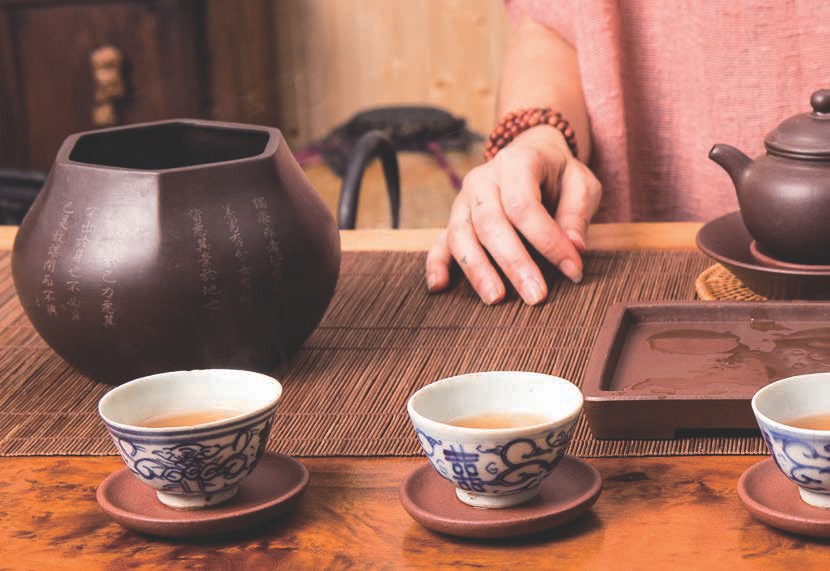
In order to learn to love tea, and to work with Her as plant medicine, we must learn to speak the language of Nature. In fact, tea is an interpreter of all the Nature wisdom around us. She helps us to understand what Mother Nature is saying to us. In order to get at the soul of tea, it is better if we start out simply; if we remove all the human elements in the tea, and reduce it - as much as possible - to just leaves, heat and water, communication is easier. In bowl tea, we look at the leaves, heat and water directly, unadorned - eye to eye and soul to soul. This helps us to learn to feel and understand the deeper, spiritual aspects of Tea that should motivate our journey in Cha Dao. It is important to learn how to receive and drink tea before one learns how to prepare it for others. Just as a burgeoning musician should first learn to appreciate, listen to and love music before playing, we must learn to take in the medicine, and be healed by it, before we can start participating in the healing of others. And that is a huge part of why we start with bowl tea in our tradition. Drink bowl tea until She talks to you, is the recipe we use around here. And when Tea does speak to you, you'll know it!
You may ask why we would then continue drinking bowl tea even after we have started the dialogue with Tea. Why continue with bowl tea if it is just for beginners? After learning the language of Tea spirit, why not move on to more advanced levels, to the finer cups of tea that gongfu brewing facilitates? The answer is that bowl tea helps us to stay free of pretension. Too much skill and mastery can make you a snob. Like Rikyu, it is important to stay connected to the simple and pure essence of tea, so that we won't miss opportunities to connect with others who are sharing tea with us from their heart, and not out of a skill. Otherwise, some fisherman will invite you over for tea and you'll be focused on his mistakes, finding fault in his tea like a snob, and missing your chance to connect to his heart and to the hospitality he is offering you. Some of the best tea sessions of my life were had with simple monks who knew nothing about tea. I once shared an empty retreat temple in the mountains with a Japanese monk. We couldn't communicate, so we'd drink tea together every day. It was simple green tea, and he made it in a Hello Kitty teapot, decanted into one cracked bowl that we shared between us. But those were, indeed, some of the "most transcendent tea sessions of my life." Conversely, I have been to very elegant tea gatherings where "experts" shared very, very expensive tea and I left feeling far less rewarded, having had a much less memorable experience.
In the end, advanced techniques are basic techniques mastered. The highest skills are the simplest. As we advance in our tea journey, a true growth and advancement of our skills will be in refining our ability to express Tea spirit, not in covering it with false costume. All our skill should serve Tea spirit, in other words. There is another beautiful story concerning Rikyu that highlights this. A man heard of the great master and traveled by foot across the breadth of the country to study with him. After around a year of diligent practice, the student asked Rikyu: "Master, what is the essence of Cha Dao? I have been here a year now and thought that perhaps you would initiate me into the essential truth of our tradition." Rikyu answered that he would, of course, share the heart of Cha Dao. "The essence of Cha Dao is this: draw the water, lay the coals, boil the water and steep the tea." The student was shocked. "That's it? I traveled across Japan for that? I could have learned that at home!" Rikyu wagged his finger back and forth with a tsk-tsk. "The day you can do that is the day I walk across Japan, put my head at your feet and call you master!"

Starting with a true connection to the essence and spirit of our art gives us a pure foundation to work from, and staying connected to the soul of tea keeps us humble and open to receiving tea shared by anyone offering us hospitality. However, the artist soon realizes that she will need to learn the technical skills of her craft in order to better express the spirit flowing through her. There is, one could say, an awful ache in the artist to translate her vision from the formless spirit into form. And it is frustrating when you lack the skill to translate your ideas to the canvas, and what comes through looks nothing like your inner vision. Learning to grind the paints, how to properly hold the brush and apply the color will help facilitate the creation of that which she imagines. Similarly, a musician must learn to read notes and hold the instrument; the playing must become second nature if she is to express the music inside of her.
By learning to prepare finer and finer cups of tea, we honor the Leaf. We bring each tea to its highest potential. A lot of life has gone into the creation of this handful of leaves. Tea is one of the most labor-intensive agricultures on Earth. And you also worked hard to earn the money to buy your tea, which had to be shipped to you, probably from far away. We honor all that energy by properly preparing the tea. A famous Ming Dynasty poet said that the two greatest tragedies in the world are the mis-education of youth and the mis-brewing of a fine tea. By playing the violin concerto beautifully, you honor the music itself, the instrument and the composer. Bringing a tea to its greatest potential similarly honors Mother Earth, the farmer and your guests. As you fall in love with tea, you will find a natural desire to refine your brewing, so that She may shine in all Her glory.

In order to elevate our tea to its potential, we have to start by learning to recognize what makes a fine cup of tea fine. We have to hone our sensitivity, refine our palates. And the magic of increased sensitivity is that it means we begin to experience and relate to more of our tea. We begin to peel away the layers and fall more deeply in love, like a married couple spending more and more time together. We are rewarded for our efforts to increase and expand our sensitivity - bestowed more facets to enjoy. This happens on all levels. A sensitivity to flavor and aroma means we will taste all the many changes in each cup. From there we can learn to experience the texture of the tea. Master Lin often says that as one progresses in tea, over time, one more and more drinks structure. Structure can be so much more enjoyable than flavor and/or aroma, especially since a sensitivity to it is not mutually exclusive to flavor or aroma. Structure doesn't come at the expense of flavor, in other words, but is, instead, an added dimension. And from there we may explore the energy of tea, and the way it relates to our subtle body.
Once we have honed our sensitivity, we then can increase our ease of brewing by practicing all the technical aspects - from laying coals to boiling the water, placing the tea into the pot to carefully covering it in water, steeping time to decantation, and so on... These skills have to become second nature, so that they can be performed without any thought or attention. They must be in our hands. A master athlete has no time to think about what to do with her body. If a ball is flying at you hundreds of miles per hour, you must react without thought. And the concert musician has no time to think between notes: the hand must flow with lightning speed across the strings. Great tea is brewed with such otherworldly grace. In that way, we become an instrument of Tea spirit ourselves - She finds in us a honed and pure channel to come through into the world. And in that way, we are as natural a part of Her journey from seed to cup as the sun that nourished Her, the water that coursed through Her leaves or the gentle farmer who deftly plucked Her without a thought.
Little children dance beautifully. They are free of pretension and ego, and are often in tune with the music in an extraordinary way. Master dancers are also free. One of the greatest ballerinas once said, "When I am on stage, there is no music and no me. There is only dance." She obviously dances freely. What, then, is the difference between her performance and the chaotic gyrations of children? Two things: one, she has a lineage. She had a teacher, who also had a teacher, and these teachers passed on to her generations' worth of dance wisdom. Second, she has skill: she has decades of practice cultivating her skills to be able to express the spirit of the music in ever-refined ways, until, after enough practice, she hones herself down to such a degree that she is no longer there, becoming a pure unadulterated expression of the spirit of the music itself. In the same way, we refine our skills until it is no longer us brewing the tea, but the spirit of the tea brewing itself!
Our tea life isn't just about a greater connection to Nature through the Leaf, but an attunement with our self as well. We must therefore cultivate both inner and outer harmony, a flow from the absolute into the relative. We learn this flow through the practice of gongfu tea, refining our sensitivity and grace as we prepare finer and finer tea over time. We must spend adequate time doing exercises to refine our palates, our sensitivity to tea and its Qi as well as some academic study of tea in order to refine our intellects. We should be able to articulate tea matters and feel comfortable doing so. A mastery of tea includes a grace with all kinds of teaware, preparation, discussion and presentation. We should know dry leaves by appearance and smell and be able to prepare them with a grace and beauty that transcends the ordinary. We should strive to brew the tea the way it wants to be brewed, recognizing its inner nature and becoming a graceful part of that flow. We should also develop our aesthetic sensibilities, in recognition that beauty significantly affects our ability to transform others through tea. A beautiful tea arrangement aids in one's transformation. All of this refinement should temper our spirits and teach us how to live in grace.
The magic of refining your skill through gongfu tea is that over time you come to realize that you are also refining yourself. After enough technical skill is gathered, you realize that it is you who is in the way. The more refined you are, the better your art is. There is an old Chinese story that demonstrates this. The student asked the master how to brush the perfect scroll of calligraphy, to which the master replied: "Perfect yourself and paint naturally!" So, actually, we are mastering ourselves and the art of living a human life through our gongfu tea practice. After all, it is we ourselves who are becoming more and more sensitive and more and more skilled. And as we hone ourselves to the point that we disappear in Her, our mastery will be fulfilled, though never finished growing, refining and transcending.

Gongfu tea and bowl tea do not meet at a solid boundary that divides them, but rather overlap, helping the teawayfarer to grow in each practice. Sometimes when we take guests out to buy teaware, they are confused about the criteria for buying gongfu versus bowl teaware. Questions concerning the aesthetics of gongfu tea are less relevant, for example, as gongfu teaware is measured by its ability to produce fine tea. Choosing teaware for bowl tea, on the other hand, is much more of a subjective, aesthetic process. You have a lot more room to choose based on the appearance of the teaware. But this doesn't mean that there are no functional criteria in bowl tea. There are. For instance, choosing a side-handle pot that doesn't add flavor to the tea, pours well, etc.; or bowls that are the right size and shape, and have a nice foot so they aren't too hot to hold. We also like bowls that are lighter in color so that we can see the tea liquor. And there are considerations for form in gongfu tea as well, like the craftsmanship of a fine Yixing teapot. These are just some of the more obvious ways gongfu and bowl tea overlap. There are many others.
One of the things I am most proud of when it comes to our tradition of tea is the relationship between gongfu and bowl tea. The way these two brewing methods work together to cultivate a Chajin on their tea journey is nothing short of magical. They work together quite harmoniously, encouraging precisely what the other one needs to complete one's understanding of tea. One provides the subtlety and refinement, the understanding and depth of tea skill, and the other provides the ceremony and meditative space. Gongfu tea hones our sensitivity while bowl tea increases our equanimity.
The Buddha said that equanimity and sensitivity are the wings to enlightenment. Awakening and balance must co-evolve. If we increase our sensitivity, experiencing the things we already feel to a greater degree and also experiencing things we haven't felt before because they were too subtle, and we do not at the same time develop our equanimity, we will feel overwhelmed by the added depth. If we feel pushed beyond our limits by a painful experience, imagine if it was heightened by several times. A lot of sensitivity without equanimity means we will be off-balance even more often. Similarly, greater and greater equanimity without sensitivity is like taking drugs, becoming peaceful but numb to life. The ideal is to increase our patience and equanimity while also cultivating heightened presence and perception - being tuned into our experience more often, and with a balanced, peaceful heart, in other words.
In our tradition, gongfu tea helps us to grow our awareness and bowl tea helps awaken our balance. We learn to refine our palates and our tea-brewing skills while staying connected to simplicity and harmony through bowl tea. The function and coordination we learn in gongfu tea refines our bowl tea, improving our brewing and adding grace to the ceremony; the mindfulness and sacred intention we bring to bowl tea ceremonies is also a valuable asset in preparing fine gongfu tea that changes our lives and the lives of our guests. And believe us, lives can be changed by tea! In mastering these two aspects of tea simultaneously, we explore tea at all levels, from the depths of spirit to the delights of the senses, from simplicity to refinement and from the gross to the subtle.
In the Center, we try to practice keeping gongfu and bowl tea a bit apart, in energy and practice. There are many ways in which the two facilitate one another, enhancing and expanding upon what the other lacks. As I discussed above, they do not so much meet as overlap. Still, it is also important to practice them separately and not confuse the energies, and for some very good reasons.

Sometimes it seems that the mind that motivates each of these tea practices frustrates the fulfillment of the other in actual application. They are not really so strongly antipodal, actually, but it can seem so to the Chajin trying to work with bowl and gongfu tea. The discriminating mind that helps us judge and evaluate, sensitize and refine in gongfu tea is a barrier to the meditative space that bowl tea is facilitating. Conversely, the relaxed, ceremonial and tranquil acceptance of bowl tea can, at times, be a barrier to a growing hypersensitivity for all the minutiae in gongfu tea - from the effects of various types of teaware to the subtle variations in mouthfeel from tea to tea. When the energies of the two brewing methods are confused, they frustrate the culmination of either one. Part of why they work so well in a life of tea is that they are practiced separately. It is, in other words, their friction that is powerful, just like it is the space between pieces of charcoal that causes heat, rather than the pieces themselves. It is the effects of a gongfu practice that benefit bowl tea, just as the meditative mind that is encouraged by a bowl tea practice will help one make progress in gongfu tea. They are like a beautifully harmonious couple that is healthy and whole because they give each other the space to be unique, encouraging a more complete version of each by being separate, yet in relationship with the other. There is a dot of gongfu in bowl tea, and vice versa, but they also taichi in harmony because they are distinct.
The more important reason why we must be careful how we share these two practices from one space, the Center, is that we must honor their unique sources and heritage. Our bowl tea tradition is old, shamanic and meditative. It is passed on through the spirit. Our gongfu tradition comes via Master Lin in Malaysia. They are different practices from different lineages, and we who build houses of tradition that hold more than one must work to make sure that all the lineages which inhabit this Center are happy and working healthily together, each honored and respected individually. Though there is fusion, it must be done with care so that neither is damaged by the relationship, and both are, rather, encouraged and grow in benefit by being together.
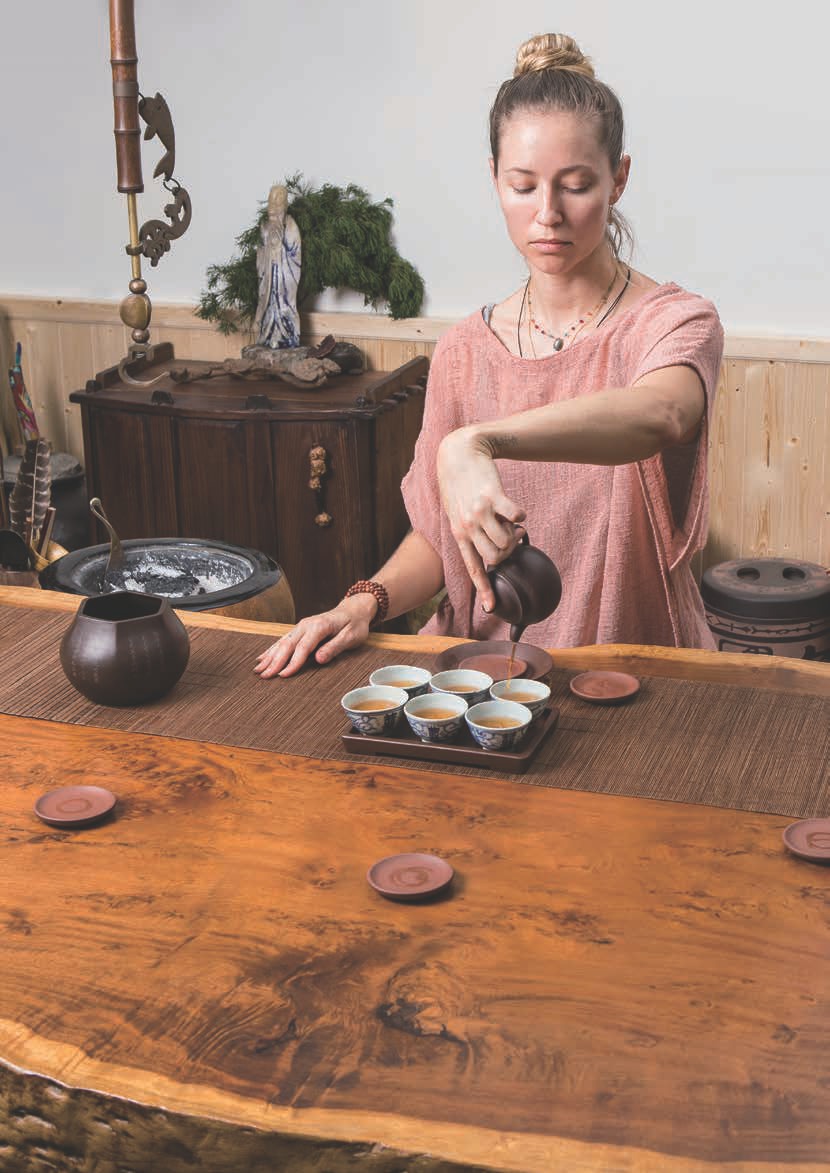
As an analogy, let's say that we practiced a deep and spiritual kind of drumming, related to all the drumming traditions of the world. It is older than any one of them. And then, we travel to Spain to learn flamenco guitar. While we are in Spain, we are sure to practice only flamenco, bringing nothing of our previous ideas, traditions or practices with us, so that, as much as possible, we may fully absorb the flamenco way. And our flamenco teachers are old-school - very conservative and traditional. Their music changes our lives and our approach to music in general. Later, as we progress further in music, we see that this percussion we've learned can work very well with flamenco, and we can even envision an album composed of both. Our first goal will be to make sure that our flamenco teachers are honored to have their influence on our album. We don't want them to scratch their heads and wonder what we have done to their precious tradition. Instead, we want them to smile in understanding, bragging to their friends that their tradition is on such a beautiful album.
Hopefully, you can see why this analogy works. Bowl tea is the drumming and gongfu the flamenco. Master Lin is also a very old-school teacher and we want to make sure that the brewing method he has handed down to us is respected and honored, and that it benefits from being "on the same album" (or in the same Center) as bowl tea. And that is a big part of why we practice our different brewing methods separately.
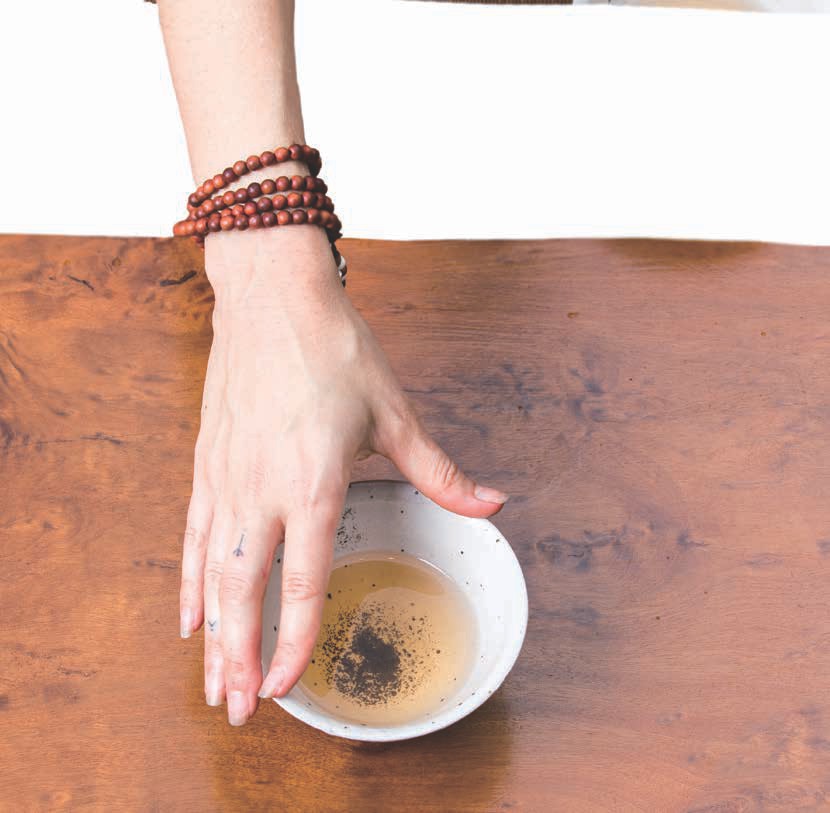
As you can see, bowl tea and gongfu tea are both apart and one and the same in spirit. They work well together, facilitating a holistic approach to tea brewing that allows us to understand all facets of the tea world. In that way, our tea is able to reach into all the areas that allow for cultivation and service. There is a lifetime in either of these methods, but somehow the practice of both serves to awaken the sacred ceremonial plant medicine and refined cultivation that tea has always been to people.
The Yin and Yang balance and the flow of the Dao revolves the essence. Everything is just as it should be, and without the need to steer, balance resolves itself, of its own accord. That is the point at which we find our way, and all the ten thousand words cannot say a thing about the infinitely small, yet vast as all the Heavens, point of harmony we then stand precariously poised upon. A cup in one hand and a bowl in the other - one eye open and one closed in meditation, the Buddha serves up his inner, unsaid (lotus held high) and outer, spoken sermon all at once. You could drink the lotus-bowl in the cup, just as you could find the sermon-cup in the bowl. But it is much better if we receive the flesh and the spirit, the bones and the blood of the teachings!
